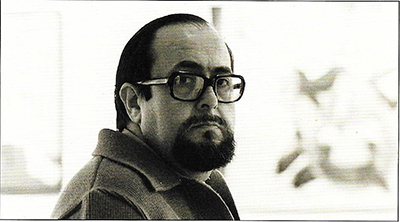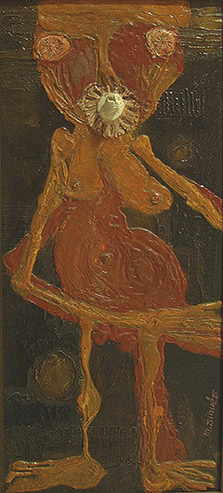The piece of the month of January 2018
THE MAN WHO HIDES THE FACE OF MARIANO SINUÉS
José Mª Muruzábal del Solar
PhD in History of Art
Mariano Sinués (Zaragoza, 1935-Pamplona, 2017) is part of the great generation of Navarrese painters born in the late twenties and early thirties of the twentieth century. These painters, perhaps the greatest generation of Navarrese painting, are Muñoz Sola, Ascunce y Lasterra, Echauri, Beunza, Buldain or Martín Caro, Eslava, Apezetxea and Viscarret, to mention only some of the best known. In final, Sinués is part of the artistic generation that has been the protagonist of Navarrese painting in the second half of the 20th century. They picked up the pictorial baton of the generation born at the end of the 19th and beginning of the 20th century and filled the Navarrese cultural environment of the second half of the century with their work. Some of them have already disappeared, some very prematurely like Martín Caro, but others, thank God, continue to occupy their place, in plenary session of the Executive Council artistic and productive vigor, within our Community. Among the artists of this generation there are very different styles and personalities. Some of them have worked the landscape in its most traditional line, as are the cases of Lasterra, Beunza or Viscarret for example. Others have taken much more evolved stylistic lines, such as Eslava, Martín Caro or Buldain. And there are also artists with their own register, with an unmistakable style, as is the case of the artist we are dealing with in these lines, Mariano Sinués. A deep, reflexive and very elaborated work, halfway between expressionism and surrealism, characterizes Sinués within the pictorial panorama of Navarre.
Mariano Sinués was born in Zaragoza on February 7, 1935, just before the Spanish Civil War. In 1940 he is already settled in Navarra, specifically in Elizondo, to establish his residence since 1942 in Pamplona. He is an Aragonese artist by birth but Navarrese by his residency program, feeling and adoption. He studied with the Marist Brothers in the old house of high school San Luis, located in Navas de Tolosa Street. Already during his stay at high school he showed his artistic vocation, in spite of the fact that in his family there was no artistic background, with the illustrations he made for the school magazine "Juventud", at the time of Brother Santiago Erro. degree program After successfully completing his secondary education at programs of study , he studied Law at the then nascent University of Navarra.

Mariano Sinués in 1989. Photograph by Belén Sinués.
Parallel to the university degree program he continued to deepen his dedication to the art world. During those years, in the SEU he worked as a designer and illustrator of posters, catalogs, programs, as well as a decorator of theatrical works and interiors. In Madrid he attended advanced courses on color psychology, advertising, poster basics, and attended the master classes of J. R. Cid and S. Valverde on the principles of aesthetics. In spite of this, he must be considered a fully self-taught artist. At the end of the 50's he traveled through Paris, Madrid and Catalonia, soaking up the art world, visiting artists and museums. He won several awards, such as the award San Jorge free painting in 1959 or the award Zaragoza in 1960. In 1961 he had his first individual exhibition , in the conference room of art of the CAMP of García Castañón in Pamplona. During the decade of the 60's he was related to the artistic group SAAS of Soria, founded by the ceramist Antonio Ruiz and the painter Molinero Cardenal.
However, life took him professionally into the field of graphic work in different companies in Navarre. In 1960 he joined forces with Jorge Ramón Sarasa, founding the agency advertising "2S advertising". In 1968 he was hired as a graphic designer by Litografía del Norte, where he coincided with Jesús Jáuregui. Together they investigated in the Graphic Arts; Jáuregui as a specialist in printing and paper qualities and Sinués as a designer specialized in color, form, typography and visualization of ideas. Subsequently, business was acquired by Grafinasa. Shortly afterwards, both joined Gráficas Castuera, where Mariano Sinués remained for more than 30 years, until his retirement in 2000. This meant that he was always, as he himself gracefully points out, a painter "of average workshop ", as he devoted himself to painting in the afternoons and on holidays. However, he did it with a patience and constancy worthy of praise, since in fifty years he has not stopped painting. This perseverance is something extraordinary and worthy of note, since most of his peers of his generation have been professional painters. And we can also add that it is surprising the coordination he achieved in his occupations; his work in the Graphic Arts has never hindered his painting, achieving rather a mutual understanding and support between both activities.
Throughout these sixty years of his second profession, Mariano Sinués has painted in oil, drawn, made posters, illustrated books, practiced engraving, designed playing cards and an endless list of activities that would be too long to mention. During his degree program has developed more than 20 solo exhibitions in Tudela, Zaragoza, Pamplona, Soria, Logroño, etc.. Among them it is necessary to emphasize the anthological one of 1983 in the Pavilions of the Citadel of Pamplona, the one of 1999 in the conference room of the CAN of Madrid, and the one of the year 2001, titled "the dance of the death", in the Museum of Navarre. His collective exhibitions total around a hundred. His relationship with the Peña Pregón and its magazine has been evident in the illustrations that appear in the magazine, especially to accompany texts by his great friend José Mª Corella. In addition to this, the Peña Pregón itself organized a exhibition to commemorate the 50 years of the painter's artistic career, in the premises of the Casino Principal of Pamplona, between May and June 2004. The painter passed away on September 9, 2017 in Pamplona.
The artistic work of Mariano Sinués is difficult to define given its constant evolution. In the 50's, he starts from a figuration of subject expressionism. From his beginnings he feels a predilection for depicting the human figure. Later he will go through a clearly materialistic stage, in which the artist experiments with different procedures. This period will cover the end of the 60s and most of the 70s. At this time his canvases are approaching a surrealist style, although he never abandons that deep and staff expressionism he has always shown. The 80's, 90's and the end of the 20th century projected a more colorful and optimistic work. His paintings move towards abstraction, although he never quite lands on it. Finally we have to discover his final work, already in plenary session of the Executive Council XXI century, in which he was immersed until the end of his life. It is a different production, daring, deeply questioning for the spectator. He can be seen experimenting with new technical procedures, with washes and other essays that speak of an artist who has never ceased to travel new paths of plastic expression. In these works an evident surrealism appears, overflowing to unsuspected limits the ingenuity and imagination that the artist possesses.

The man who hides his face. Mariano Sinués.
The work we present here (mixed media / panel, 70 x cm., ca. 1970-75), preserved in an important collection of Navarrese art in Pamplona, clearly represents the most characteristic of Mariano Sinués' aesthetic work. We are before a vertical format composition, endowed with a marked sense between surrealism and expressionism. In the foreground, occupying practically the entire composition, there is a strange and deformed being, very much in the line of those macabre and sinister, deformed and caricatured characters that made up the creative universe of Sinués. This being is difficult to describe, with a large head, from which emerges a pronounced nose added in relief, with very long arms and deformed legs. A being, in final, caricatured, ugly and unpleasant, which seems to be taken from the modern space movies that are projected on cinema screens. The very degree scroll of the work wonderfully connects with the characteristic humor, between the sarcastic and the gloomy, of the author. "The man who hides his face" says the degree scroll; it is evident that he has reason to hide it, although with his Issue and the size of his nose, the topic is difficult to present. The coloring and intonation of the work perfectly help its purpose, built in dark and heavy tones, with yellows, ochers and reddish tones. The painting is signed in the lower part of the right side, with the initial of the author's name and surname . Also noteworthy is the subject and the impasto with which this work is elaborated, built with a clearly material profile .
We are, in final, before an artist with a work staff, original and inimitable; of a serious man, tireless worker, who has been able to combine the exercise of another profession to workshop complete with painting, something very difficult to maintain over time. An artist endowed with a vision between sarcastic and lyrical, always highly original, of life and its actors. But equally exciting is the contemplation of his works and the mental exercise that each one of them provides. Many things can be said about his work, as critics and art historians have already said; for my part, I think that the paintings of Mariano Sinués will please, frighten, excite, worry, seem horrifying... but, surely, they will leave no one indifferent.
I end these brief notes with the approach made to the work of Mariano Sinués by the well-known art critic Salvador Martín Cruz in the Catalog of the exhibition of the Citadel of Pamplona, in 2007, "all this inventiveness that flows in the fountain of his brain is not the casual fruit of a more or less horny and perverse mind - it is clear that Mariano is anything but perverse - given to nonsense. Far from it. It is the answer given by a man of today who sees, associates, interprets and, as far as he can, manifests an ethical commitment to the truth -of course his truth- and to what the contemplation of the fragment of the world in which geography and the calendar have made him live suggests to him. And for many philosophers, psychologists, sociologists and historians this is, since the angel with the flaming sword threw man out of Eden, the best time lived by the history of mankind".
BIBLIOGRAPHY
MARTÍN CRUZ, S. and CORELLA, J. M., "Mariano Sinués", Catalog exhibition in Pabellón de Mixtos de Ciudadela de Pamplona, Pamplona City Hall, 2007.
MARTÍN CRUZ, S. and others, Pintores Navarros III, Pamplona, CAMP, 1981, pp. 120-127.
MURUZÁBAL DEL SOLAR, J. M. and Muruzábal Del Val, J. M., "Mariano Sinués, ilustrador", Revista Pregón Siglo XXI, 29 (June 2007), pp. 65-70.
ZUBIAUR CARREÑO, F. J., "Mariano Sinués", Catalog exhibition in CAN, Pamplona, CAN, 1999.
PUBLISHED WORKS
Gallery and auction house Appolo of Pamplona, session no. 22 (2008).
exhibition "Navarrese artists in a Pamplona art collection", conference room Conde Rodezno de Pamplona, November 2013-January 2014, nº 134.
